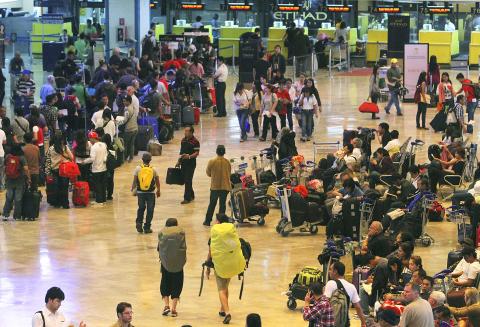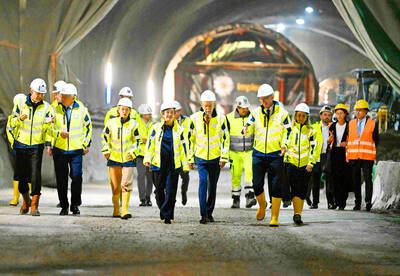It is a scene repeated endlessly at most of Southeast Asia’s main airports — planes forced to circle overhead or idle on the tarmac, and travelers stuck in serpentine lines at immigration desks, security checkpoints and baggage carousels.
It is likely to get worse in capitals like Kuala Lumpur, Jakarta, Bangkok and Manila in years to come as overcrowded airports and outdated infrastructure are twinned with a huge spike in the number of aircraft in the region.
Southeast Asian carriers have ordered US$47 billion of aircraft for the coming decade, but the deals could be under threat because of the inability of airports to keep pace. That could be a blow to manufacturers like Boeing and Airbus.

Photo: Reuters
“You can buy as many aircraft as you like, but if the infrastructure does not keep up, then you are going to see a degraded service that may prevent you from executing plans to grow the airline,” Association of Asia Pacific Airlines -director-general Andrew Herdman said.
The problem could force low-cost carriers such as Malaysia’s AirAsia and Indonesia’s privately held Lion Air — the world’s biggest buyers of passenger jets — to delay or even cancel some orders from Airbus and Boeing.
Jakarta’s Soekarno-Hatta International Airport now serves more than 51 million passengers a year, more than twice its design capacity when it was built in the mid-1980s.
Bangkok’s main Suvarnabhumi Airport is often beset by two-hour immigration lines and is running over capacity less than six years after it opened, which led Thailand’s government to encourage low-cost carriers to move to the old Don Muang Airport to help ease congestion.
Passengers can wait for hours at Kuala Lumpur’s overcrowded budget terminal, the hub for -AirAsia. After clearing immigration lines that can be at least 50 people long, the walk to the plane at the tarmac can be hundreds of meters with only a strip of corrugated steel overhead as cover against the elements.
With pressure from AirAsia and scenes of chaotic check-ins, -government-linked operator Malaysia Airports is rushing to complete another budget terminal that is due to be up and running by April next year.
Projected construction costs have nearly doubled to 3.9 billion ringgit (US$1.27 billion) as the planned capacity of the new airport has been expanded to 45 million passengers a year from an initial plan of 30 million.
The number of low-cost carriers (LCC) and their routes have expanded rapidly in Southeast Asia over the last 10 years. Analysts and industry executives see more growth ahead due to a lack of reliable alternatives and strong economic growth.
“Ten years ago, the airports in this region would probably not have foreseen that LCC demand could be as strong as it is today,” said Chin Yau Seng (陳有成), chief executive officer of Singapore-based budget carrier Tiger Airways.
Airport congestion makes it tougher for carriers to keep their on-time performance and pushes up operating costs as planes waste fuel waiting to take off or land.
“If this problem persists for the long run, airlines in general will have to take into account all the additional costs that they have to incur and pass them on to customers,” Lion Air director Edward Sirait said. “If customers cannot accept those additional costs then airlines, whoever they are, will have to rethink their investment decisions and spending.”
Lion recently firmed up an order for 230 Boeing 737s worth US$22.4 billion, eclipsing the record for the world’s biggest commercial aircraft deal set by AirAsia when it signed up to buy 200 Airbus A320neo jets for US$18 billion.
Despite the growth and big orders, Southeast Asia remains a market that has been under served by carriers.
Con Korfiatis, vice president of Garuda Indonesia’s budget carrier, Citilink, said only 300 -single-aisle jets serve the country’s population of 230 million, compared with 3,000 in the US, which has 310 million people.

CHIP RACE: Three years of overbroad export controls drove foreign competitors to pursue their own AI chips, and ‘cost US taxpayers billions of dollars,’ Nvidia said China has figured out the US strategy for allowing it to buy Nvidia Corp’s H200s and is rejecting the artificial intelligence (AI) chip in favor of domestically developed semiconductors, White House AI adviser David Sacks said, citing news reports. US President Donald Trump on Monday said that he would allow shipments of Nvidia’s H200 chips to China, part of an administration effort backed by Sacks to challenge Chinese tech champions such as Huawei Technologies Co (華為) by bringing US competition to their home market. On Friday, Sacks signaled that he was uncertain about whether that approach would work. “They’re rejecting our chips,” Sacks

NATIONAL SECURITY: Intel’s testing of ACM tools despite US government control ‘highlights egregious gaps in US technology protection policies,’ a former official said Chipmaker Intel Corp has tested chipmaking tools this year from a toolmaker with deep roots in China and two overseas units that were targeted by US sanctions, according to two sources with direct knowledge of the matter. Intel, which fended off calls for its CEO’s resignation from US President Donald Trump in August over his alleged ties to China, got the tools from ACM Research Inc, a Fremont, California-based producer of chipmaking equipment. Two of ACM’s units, based in Shanghai and South Korea, were among a number of firms barred last year from receiving US technology over claims they have

It is challenging to build infrastructure in much of Europe. Constrained budgets and polarized politics tend to undermine long-term projects, forcing officials to react to emergencies rather than plan for the future. Not in Austria. Today, the country is to officially open its Koralmbahn tunnel, the 5.9 billion euro (US$6.9 billion) centerpiece of a groundbreaking new railway that will eventually run from Poland’s Baltic coast to the Adriatic Sea, transforming travel within Austria and positioning the Alpine nation at the forefront of logistics in Europe. “It is Austria’s biggest socio-economic experiment in over a century,” said Eric Kirschner, an economist at Graz-based Joanneum

BUBBLE? Only a handful of companies are seeing rapid revenue growth and higher valuations, and it is not enough to call the AI trend a transformation, an analyst said Artificial intelligence (AI) is entering a more challenging phase next year as companies move beyond experimentation and begin demanding clear financial returns from a technology that has delivered big gains to only a small group of early adopters, PricewaterhouseCoopers (PwC) Taiwan said yesterday. Most organizations have been able to justify AI investments through cost recovery or modest efficiency gains, but few have achieved meaningful revenue growth or long-term competitive advantage, the consultancy said in its 2026 AI Business Predictions report. This growing performance gap is forcing executives to reconsider how AI is deployed across their organizations, it said. “Many companies